Jessie, Lady Street 1889 – 1970
Feminist, socialist and political activist
Jessie Street, who lived at 2 Greenoaks Avenue, Darling Point, for over forty years, spent her life campaigning for equality and peace. Street travelled the globe advocating socialism, and lobbying for women’s and Aboriginal rights. She played a key role during the 1945 United Women’s Conference in San Francisco and in the movement leading to the 1967 Referendum on Aboriginal Rights in Australia.
Image: Jessie Street Portrait, 1930s, Falk Studios. National Library of Australia.
2 Greenoaks Avenue, Darling Point
View all plaques in Darling Point
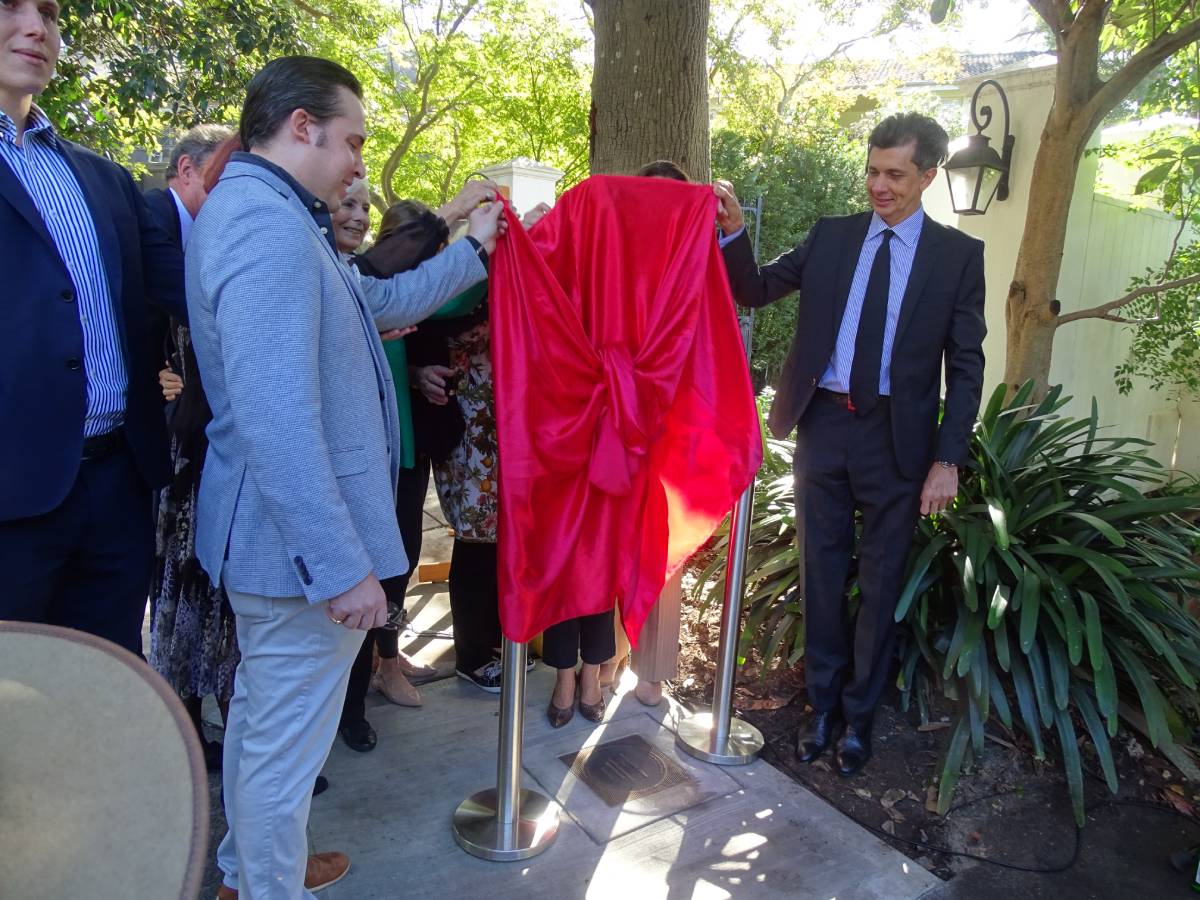
Plaque unveiling for Jessie Street, Greenoaks Avenue, Darling Point 25 May 2021. Family members with Cr. Anthony Marano (on the right).
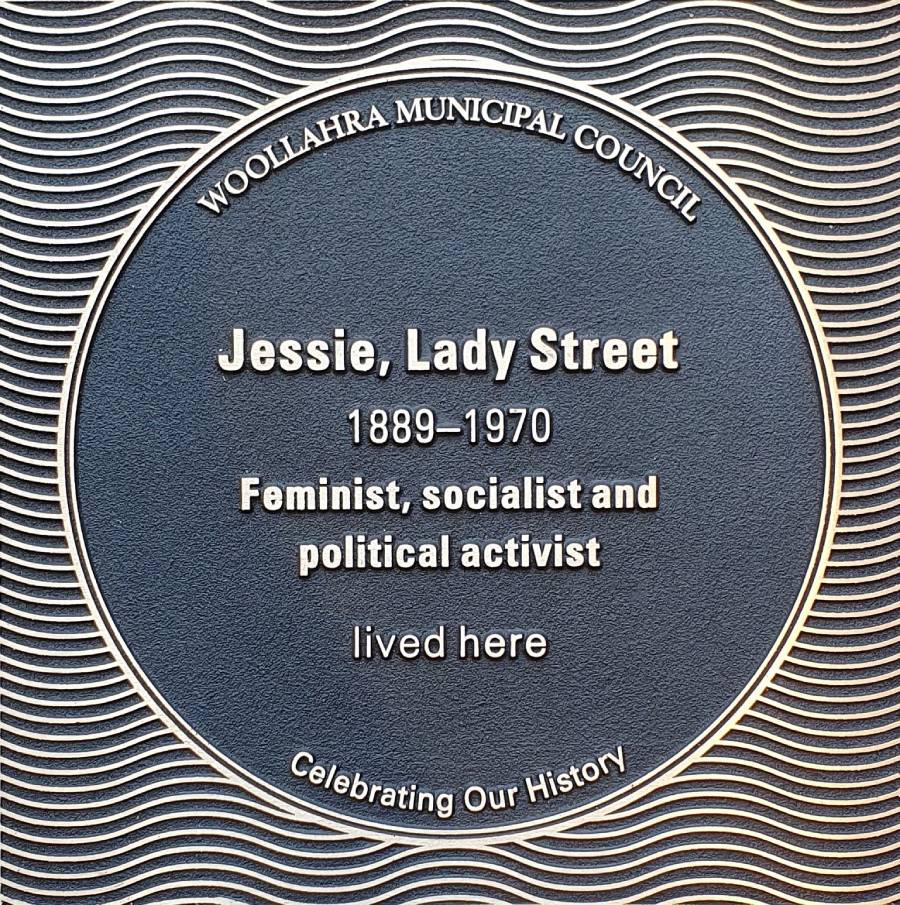
A plaque commemorating the life and work of Jessie Street was unveiled on 25 May 2021 on the footpath near 2 Greenoaks Avenue, Darling Point, where she lived for more than 40 years (the house has since been demolished).
Watch the plaque unveiling video
Gallery
Jessie Mary Grey, Lady Street (née Lillingston) 18 April 1889 - 2 July 1970
Jessie Street was lifelong feminist and activist in Australia and overseas, campaigning for women’s rights, peace and the elimination of discrimination against Aboriginal people.
"I saw plainly that the reason for these discriminations [by my father] was to protect the status, rights, and privileges of the white man vis-à-vis women and the coloured races."
Street, Jessie Truth or Repose 1966 p. 2
Jessie Mary Grey Lillingston was born on the 18th of April 1889. Her parents named her Jessie after her mother Mabel’s sister, and Mary Grey after her paternal grandmother. Jessie’s mother, Mabel Lillingston (née Ogilvie) was one of eight daughters of Edward David Stewart Ogilvie and his wife Theodosia. Jessie was born in Chota Nagpur, in Jharkhand, India while her father Captain Charles Lillingston worked for the Forest Department in the Indian Civil Service.
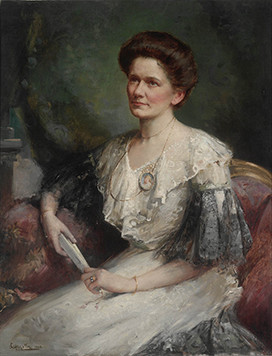
Jessie Street's mother, Mabel Harriet Lillingston (nee Ogilvie) 1905. Oil portrait attributed to Lafayette. Mitchell Library, SLNSW
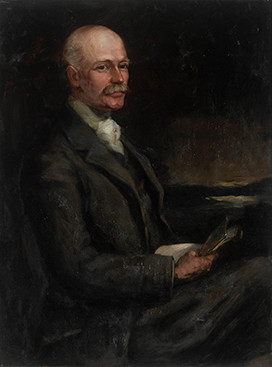
Jessie Street's father, Charles Alfred Gordon Lillingston, ca. 1905. Oil portrait attributed to Lafayette. Mitchell Library, SLNSW.
As a child, Jessie travelled across the British Empire. At the age of 3, she and her family moved to Darjeeling, India. She began her world travelling from the age of six. Within one year she spent time in Australia, Germany and other parts of Europe, England, and then returned to Australia.
When Jessie's maternal grandfather, Edward David Stewart Ogilvie, died in 1896, he left Yulgilbar, the Ogilvie's rural property on the Clarence River in northern New South Wales, to his sixth daughter Mabel, Jessie's mother. The Lillingstons went to live at Yulgilbar Castle, which had been built by E D S Ogilvie c1860. In addition to her experiences in India with “ayah” and Indian cooks and English governesses, Jessie at an early age befriended German, Chinese and Aboriginal workers on her family’s cattle station. In 1903 she left Australia to attend school in Buckinghamshire, England.
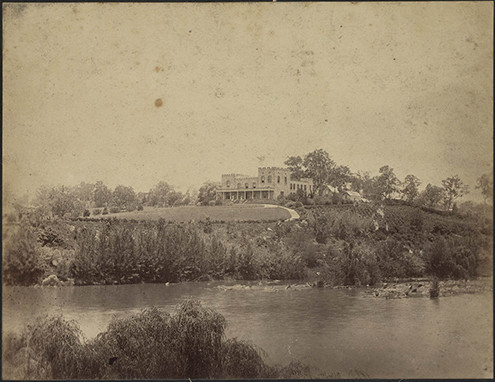
Exterior view of the Ogilvie family residence 'Yulgilbar'. Photo by J. Stevenson, Grafton, ca. 1872-1890. Mitchell Library SLNSW
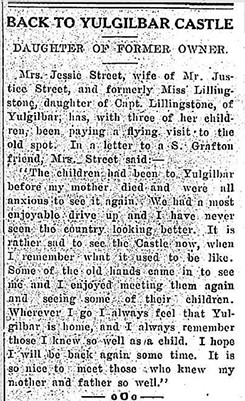
'Back to Yulgilbar Castle' The Richmond River Herald and Northern Districts Advertiser, February 2, 1940 p. 2.i
Education
Jessie's father Charles insisted that all three of his children (Jessie, Edward and Evelyn) would benefit from an English education. Jessie was enrolled at Wycombe Abbey in Buckinghamshire England between 1903 and 1906. It was a progressive girls' school with compulsory gym and preparation for universities such as Oxford and Cambridge, which by then had opened enrolment to women. Jessie's experiences at Wycombe Abbey undoubtedly solidified her already feminist tendencies.
Due to illness, Jessie returned to Australia and studied to gain entry to the University of Sydney. She continued her physical education at the Women’s College forming the Sydney University Women’s Hockey Club. Jessie met her future husband, Kenneth Street, during her university years which spanned 1908 to 1911.
When not in class or studying, Jessie continued to advocate for women’s equality on campus. She helped form a Women’s Sports Committee and actively campaigned for suitable hockey and tennis grounds for female athletes as well as uniforms sporting the schools colours. She also helped form the Sydney University Women’s Sports Union and vied on the campus for equality between that organisation and the Men’s Sports Union.
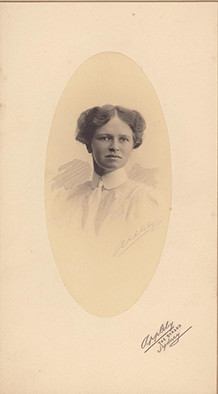
Jessie Street c1910, photography by LW Appleby from the collection of the State Library of New South Wales PXA 831/73
“I in fact pledged myself not to allow it [my sex] to interfere with anything I wanted to do, and in the future to exert all my efforts to remove discriminations against women and to gain for them equal status, rights and opportunity. I think I can say I have faithfully carried out this pledge.”
Truth or Repose p.15
After Jessie's graduation, the Streets travelled to England and Jessie became involved in canvassing for Votes for Women, a suffragette publication, in 1911. She continued travelling across Europe and through Egypt, the latter allowing her independence and self-governance. Her return home to rural New South Wales provided an opportunity to open a dairy for two years.
She sold the dairy to accompany her immediate family as well as Kenneth Street on another trip to Europe. In 1914 Jessie went to Rome for a meeting of the International Council for Women. As one of six Australian delegates, Jessie heard about the experiences of women across the world and the political, economic, and legal discrimination they encountered. .
“I came away [from the 1914 International Council for Women’s meeting] more of a feminist than ever.”
Cotheart, Lenore, ed. Jessie Street: A Revised Autobiography p. 37
Back in England just before the outbreak of World War I, Jessie again worked for the suffragette movement. She applied to be an ambulance driver, but was rejected, so then travelled to the US and worked at Waverly House in New York City, a reception house to support women arrested for soliciting, run by the New York Protection and Probation Association.
Jessie married Kenneth Whistler Street in 1916, becoming the daughter-in-law to Sir Phillip Whistler Street, Chief Justice of the Supreme Court. Her husband became a Supreme Court Judge and later Chief Justice, and was appointed K.C.M.G. in 1956. Jessie and Kenneth had four children: Belinda, Philippa, Roger and Laurence. (Sir) Laurence Lillingston Whistler Street, was named after Kenneth’s brother who died at Gallipoli, and followed his father and grandfather to become a Chief Justice of the Supreme Court.
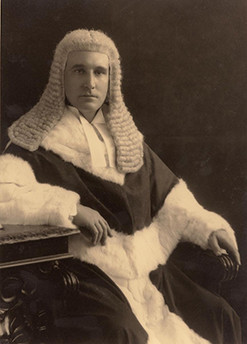
Kenneth Street, ca. 1931. Mitchell Library, State Library of New South Wales FL619924 ii
In the early 1920s the Streets moved to 6 Roslyndale Avenue, Woollahra, living there for approximately six or seven years.iii In 1928, they purchased number 2 Greenoaks Avenue, Darlinghurst, which was to be their home for the rest of their lives - in Jessie's case, until her death in 1970, and for her husband until 1972. Adjacent to the property was a tennis court that Jessie purchased under her own nameiv. The four Street children, friends, and family all enjoyed using the court.
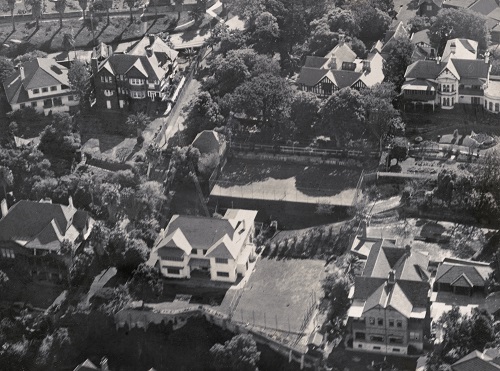
Image: Houses in Greenoaks Avenue and Marathon Road, Darling Point. The white house in the middle foreground is 'Lodore', 2 Greenoaks Avenue, home of Sir Kenneth and Jessie, Lady Street, for over 40 years (now demolished). Woollahra Libraries Digital Archive PF000035.
During the 1920s, Jessie Street was heavily involved in Sydney’s women’s organisations, including the Social Hygiene Association that helped deal with the realities of prostitution and diseases. She started a domestic services business to help hire out workers and managed the finances herself. From there she also created the Home Training Institute in 1927 to help educate and train domestic workers. Street was a keen advocate for standardising wages, skills and conditions for domestic servants.
During this decade and the next she was occupied by her work with the Feminist Club (president in 1928), and associated with the NSW National Council of Women. Both the club and council felt more social than political to Jessie. Seeking to make changes at a federal level, Jessie - with a small group of other women - established the United Associations of Women in 1929 operating under the motto ‘For freedom and equality of status and opportunity.' In 1934 the Equal Guardianship of Infants Act became law in New South Wales thanks to her efforts in granting mothers equal rights to fathers.
Socialist & Justice in Employment
Jessie travelled extensively over the next few decades including a trip in 1930 visiting family, friends and contacts around the world whom she had met on prior travels. Street also undertook extensive travel with her daughter Philippa across Europe, the Soviet Union and US in 1938. During these trips Jessie Street networked to advance the causes about which she felt passionate - feminism and justice for women workers. She also provided her children, especially her daughters, with the worldly experience of travelling to meet with Australian ambassadors, contacts from the League of Nations, politicians and feminists.
During the 1930s depression, equal pay for equal work was a particularly critical issue, as companies would lay off male workers and hire females at practically half the wage. Primarily through the United Associations, Street focused efforts on unionising nurses, encouraging women to farm during the depression years, introducing a General Social Insurance Scheme for families, implementing a variety of training schemes, and ending discrimination against married female teachers. Some of her ideas were immediately successful, others fell short, while still others began campaigns that would only change over the next twenty years.
Jessie Street became a member of the Australian Labor Party between 1939 and 1949. Her world travels, particularly to Russia, had introduced her to socialism and Jessie was particularly drawn to its social benefits of equality. She ran for Parliament on a few occasions as a member of that party as well as an independent, but was never elected.
Wartime campaigns
"Mrs Street is associated with admirers whose enthusiasm is such that you rather wonder whether Mrs Street goes round the world, or vice versa."
'Globe-trotting Grandmother' Sydney Morning Herald 21 March 1945 p 7 v
In the 1920s Street began her support for peace, disarmament and negotiation rather than conflict, by joining the executive council of the New South Wales League of Nations Union. Participation in this organisation through the 1920s and 30s (especially on her international trips networking with other women in the organisation) paved the way for Jessie's role as the only female representative from Australia in San Francisco in 1945.
During World War II, Jessie worked for a short period in 1943 as a munitions worker. Even during this short stint in the work force, Street became acutely aware of the inequalities between male and female workers and used her exit interview to secure the right for women workers to smoke on the job at that factory, as their male counterparts did. She drew on this experience in the munitions factory for other wartime campaigns, including establishing a committee for internees, and lobbying for equity between the sexes for staff serving the country in the Army Medical Corps, Australian Women’s Army Service and the Women’s Auxiliary Air Force. Although equal pay was not achieved, gratuities for ex-servicewomen were made equal to those for ex-servicemen.
The 1943 Woman’s Charter Conference provided an opportunity for females and organisations from across the Commonwealth to gather and set out aims. As more and more women engaged in the economic efforts necessitated by war, people had begun to take for granted the struggle for equal status among the sexes. Representatives from every state and 91 organisations attended to create over two dozen resolutions in an Australian Woman’s Charter. Some of the highlights were to eliminate sex discrimination in the Public Service sector including eradicating pay discrepancies, achieving economic independence for married women, and establishing an outline for women’s role in the peace and post-war reconstruction periods.
While working to establish a body of the UN Relief and Rehabilitation Administration in Australia, Prime Minister Curtin asked Jessie Street to serve as a member of the Australian delegation to establish the new UN at the United Nations Conference on International Organisation (UNCIO). She was involved in separate committees that dealt with the establishment of the Security Council and economics and society. Street was instrumental in the article that women and men would have equal eligibility to participate in the UN.
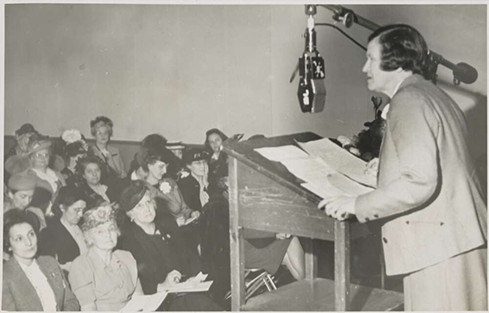
Mrs Jessie Street speaks to delegates of the United Women's Conference in San Francisco, 19 May 1945. National Library of Australia 136980683
In a 1945 recording held by the NFSA, Jessie Street addresses the inaugural meeting of the Women’s International League of Radio and describes the work of women delegates. Listen to the recording here: Jessie Street speaking in 1945
She proceeded to travel through the US and onto England, Russia and India after the end of the war. Street’s last official political appointments came in 1947 and 1948 when she was asked to be Australia’s only female delegate to the UN Commission on the Status of Women. Appointed by Prime Minister Curtin of the Labour party, she was shocked by his sudden heart attack and death in 1945. His loss as an ally marked a turning point in her ability to influence political change.
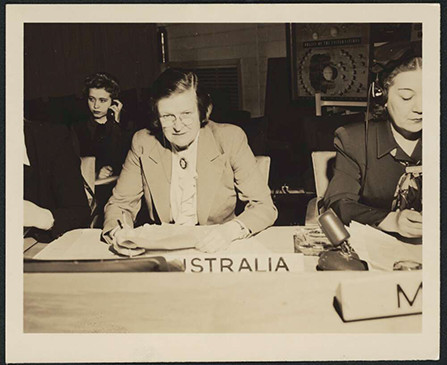
Jessie Street representing Australia at the United Nations, 194- . National Library of Australia nla.obj-231551090
Cold War Freeze results in Global Peace Activism
Since her return from a 1938 world trip that had included Russia, Jessie was labelled a socialist, and, inaccurately, as a communist. Although she was never a member of the communist party, Street did attempt to educate Australians in an understanding of Russian society. She was a member of the Society for Cultural Relations with the USSR and a lecturer on socialism. Street was elected chairman of the Russian Medical Aid and Comforts Committee which accumulated supplies for the people of Russia, specifically sheepskins. She was also a founding member and first president of the Australian Soviet Friendship Society.
“Jessie, you are 40 years ahead of your time” – Phillis Webster commented after attending one of Jessie Street's lectures about Russia.
Due to these sympathies just prior to the outbreak of World War II and during the Cold War, Street was nicknamed “Red Jessie.” With her husband’s increased public profile as Supreme Court Chief Justice, Jessie Street moved to England between 1950 and 1956. During that period she travelled extensively, mostly related to the peace movement. However, she was not welcome everywhere - her visa was refused by the USA, she was deported from France and even her Australian passport was withdrawn by the Menzies government.
During her last 20 years of public life, Jessie continued to work on the Commission for the Status of Women, United Associations of Women (which was the NSW branch of the Australian Federation of Women Voters), the Aliens Control Committee that and the World Peace Council. She was “closely involved in the drafting of the Declaration of Human Rights and the establishment of the Human Rights Commission.” vi
Homecoming & Aboriginal Rights
Through the Australian Peace Congress in 1950, Jessie met with Faith Bandler, the National Secretary of the Federal Council for the Advancement of Aboriginals and Torres Strait Islanders.
Returning to Australia in 1957, Jessie Street travelled to the Northern Territory and Western Australia. With this trip, she was introduced to the experience of Indigenous Australians. Her enthusiasm to change the Constitution culminated in Australia’s 1967 Referendum. It provided for the removal of a clause that excluded Aboriginals from the census count and from being subjected to federal laws. These two changes were overwhelmingly supported by the general public.
"She was always brimming with practical ideas," said Faith Bandler, national secretary of the Federal Council for the Advancement of Aboriginals and Torres Strait Islanders.
"Our organisation itself was Jessie's brainchild. So, in fact, was the national referendum. She rang me up late one night in 1956 (she always rang very late or very early!) and said in her lovely, cultivated voice:
"You can't get anywhere without a change in the Constitution, and you can't get that without a referendum. You'll need a petition with 100,000 signatures. We'd better start on it at once." "And we did. Jessie's role in our movement was absolutely vital. And she never wanted honor and glory. She'd give ideas away, and the credit along with them."
'Jessie Street - Salute to a Class Traitor', The Australian Women's Weekly, August 5, 1970, p. 4. vii
Jessie Street returned to her Greenoaks Avenue home and in 1960 began writing her memoirs. A first volume was published as Truth or Repose (1966), titled after reading an 1840s essay by Ralph Waldo Emerson:
‘God offers to every mind a choice between repose and truth. Take which you please--you can never have both.
Ralph Waldo Emerson
Hazel de Berg interviewed Street in 1967 and a copy of the audio file is held at the National Library. Jessie Street moved into a nursing home in 1968 and passed away two years later in 1970.
Committees
Jessie Street served on the following committees:
- NSW Social Hygiene Association
- Feminist Club
- National Council of Women
- League of Nations Union
- Council of Action for Equal Pay
- Russian Medical Aid and Comforts Committee
- United Associations of Women
Legacy as a practical humanitarian
“[Jessie] Street went against the conventions of the era to make her political mark as a voice for Indigenous peoples and women's rights on the international stage.
She was a prominent presence in San Francisco, and sent the message of the new international order far and wide through her radio presentations transmitted back to an interested Australian audience."
Professor Glenda Sluga, University of Sydney viii
Jessie Street's life and work as a campaigner for women’s rights, the peace movement and the elimination of discrimination against Aboriginal people, is honoured by a number of organisations which are named after her. These include:
The Jessie Street National Women’s Library was established in 1989, the centenary of Jessie’s birth, and named in her honour. The library's charter is 'To collect, preserve and promote knowledge and understanding of the cultural heritage of all women; social justice for Aboriginal and Torres Strait Islander peoples; international friendship and peace'.
Each year the Jessie Street Trust awards a grant 'to support campaigns and projects in line with Jessie's values, including the rights of women and indigenous people, peace and disarmament, and the elimination of discrimination'.
Jessie Street Gardens, near Circular Quay, City of Sydney was opened on Friday 7 December 1990.
Council of the City of Sydney.
JESSIE STREET GARDENS WAS OPENED ON FRIDAY 7 DECEMBER 1990 BY THE LADY MAYORESS OF SYDNEY MRS. CANDY BINGHAM IN THE PRESENCE OF THE RT. HON THE LORD MAYOR OF SYDNEY ALDERMAN JEREMY BINGHAM AND SIR LAURENCE STREET, AC, KMG AND DEDICATED TO THE ACHIEVEMENTS OF AUSTRALIAN WOMEN.
L.P. Carter OBE Town Clerk
JESSIE STREET 1889-1970
Jessie Street campaigned tirelessly throughout her life for women's rights, social justice reforms and international peace. Co-founder of the United Association of Women, she was an activist in the struggle for equal pay for equal work. In 1945 Jessie Street was a member of the Australian delegation to the San Francisco Conference which established the United Nations organisation. She helped lead the movement that resulted in the successful referendum to eliminate constitutional discrimination against Aborigines.
Wording on bronze plaque, Jessie Street Gardens, 29 Loftus Street, Sydney.
General
Cotheart, Lenore, ed. Jessie Street: A Revised Autobiography The Federation Press, Marrickville, NSW, 2004.
Radi, Heather, 'Street, Lady Jessie Mary (1889–1970)', Australian Dictionary of Biography, National Centre of Biography, Australian National University http://adb.anu.edu.au/biography/street-lady-jessie-mary-11789
Sekuless, Peter, Jessie Street: A Rewarding But Unrewarded Life, University of Queensland Press, St Lucia, 1980.
Street, Jessie, Truth or Repose, Australasian Book Society, Sydney, 1966.
Street, Jessie. Jessie Street interviewed by Hazel de Berg in the Hazel de Berg collection [sound recording]. 1967 National Library of Australia. https://nla.gov.au/nla.obj-591100020
The Australian Women's Register - Jessie Street
A large collection of Jessie Street's papers are held by the National Library of Australia - these include papers, correspondence and photographs.
Obituaries
Gollan, W.E. 'Street, Lady Jessie Mary (1889–1970)', Obituaries Australia, National Centre of Biography, Australian National University, http://oa.anu.edu.au/obituary/street-lady-jessie-mary-11789/text35297 ix
Kay Keavney, 'Street, Lady Jessie Mary (1889–1970)', Obituaries Australia, National Centre of Biography, Australian National University, http://oa.anu.edu.au/obituary/street-lady-jessie-mary-11789/text35298 x
Footnotes
i 'Back to Yulgilbar Castle'. The Richmond River Herald and Northern Districts Advertiser February 2, 1940 p.2 http://nla.gov.au/nla.news-article125947916
ii Street family portraits and portrait groups PXE 1037/Box 1, SLNSW https://archival.sl.nsw.gov.au/Details/archive/110340012
iii According to the Sydney Sands Directories, the Streets are listed at 6 Roslyndale Avenue, Woollahra from 1922 through 1928 but Jessie Street's autobiography stated they first moved there in 1920.
iv Woollahra valuation records, Double Bay Ward, 1927, 1928, 1950, 1968. Her autobiography stated they first purchased the property in 1927 for £8,500. An adjacent the tennis court was later purchased in Jessie’s name.
v 'Globe-Trotting Grandmother'. The Sydney Morning Herald, March 21, 1945, p. 7. http://nla.gov.au/nla.news-article17937861
vi Cotheart, Lenore, ed. Jessie Street: A Revised Autobiography The Federation Press, Marrickville, NSW, 2004, pg 217.
vii 'Jessie Street - Salute to a Class Traitor'. The Australian Women's Weekly, August 5, 1970, p. 4. http://nla.gov.au/nla.news-article46186803
viii 'Sydney's forgotten connection to the birth of the United Nations'. University of Sydney News. 22 October, 2015.
ix Originally appeared as Gollan, W.E. “Jessie Street: A Life Nobly Spent for Justice, Humanity” Tribune (Sydney), 15 July 1970, pg 8.
x Originally appeared as Keavney, Kay. “Jessie Street – Salute to “a class traitor” Australian Women's Weekly, 5 August 1970, p 4.
New plaques are added based on nominations from the community, which are then assessed against selection criteria and researched by a Local History Librarian.
Find out more and nominate a person or event for a plaque.